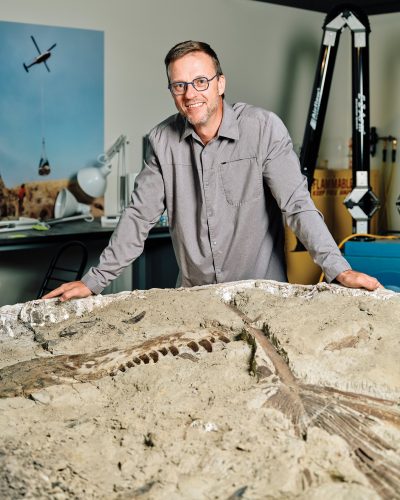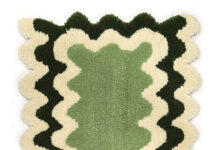
Journey into our prehistoric past with the Denver Museum of Nature & Science’s new exhibit, Discovering Teen Rex, where history is being uncovered right before your eyes. At the heart of this exhibit is a rare adolescent T. rex fossil, discovered in the badlands of North Dakota by a group of young explorers led by their father, Sam Fisher. Recognizing the significance of the find, Sam contacted his childhood friend, Dr. Tyler Lyson, a seasoned paleontologist and the curator of vertebrate paleontology at DMNS. Dr. Lyson confirmed the fossil’s importance and led a team to excavate the ninefoot- long, 6,000-pound plaster jacket containing the fossil.
This extraordinary specimen, preserving about 30% of the teenage T. rex’s skeleton, offers a rare glimpse into the growth and development of one of history’s most formidable predators during its fastest-growing phase. The fossil is now the centerpiece of the museum’s open-concept fossil prep lab, where visitors can witness renowned paleontologists carefully cleaning, preserving, and studying the T. rex—one of only four adolescent specimens ever found worldwide.
We spoke with Dr. Lyson to learn more about this incredible discovery. Here’s what he had to say.
Can you tell us more about the discovery of “Teen Rex”? “The dinosaur was found by two brothers, Jessin and Liam Fisher, their cousin Kaiden Madsen, and their father Sam Fisher while out looking for fossils. I grew up in the fossil-rich badlands of southwestern North Dakota, and some of my earliest childhood memories are of looking for fossils. I got a summer job in sixth grade collecting fossils for various academics who would visit my hometown every year. From that point on, I knew I wanted to become a paleontologist. Sam and I went to high school together, and over the years, he would send me photos of his boys finding fossils, reminding me of my childhood. It’s incredibly special to be their paleontological mentor.”
What was the on-site excavation process like? “When we started the preparation process at the museum, we had no idea what was inside the field jacket. The first two fossils uncovered were absolutely jaw-dropping— the articulated lower jaw with 12 serrated teeth and a giant palm frond complete with its stem! Both are truly world-class fossils, and finding them together is unheard of.”
Why is studying these fossils still important? “This specimen offers a crucial insight into the growth of this iconic predator— how T. rex grew and how its body changed as it developed from a small, chick-sized animal into an ~8,000-pound apex predator. To understand how and when the skeleton changed over time, you need juvenile specimens, and while there are over 100 known T. rex specimens, only five or six are juveniles.”
How does the exhibit’s open-concept lab work? “This exhibit allows guests to interact with scientists working on the juvenile T. rex fossil. Every day, the scientists uncover more amazing fossils, so the exhibit is always changing. We built the lab with as many windows as possible so guests can view the dinosaur from many angles. The windows open up so guests can talk to the scientists while they work on the fossil.”
Any advice for young aspiring paleontologists? “There are discoveries to be made all over the world! No matter where you live, you could make an important paleontological or natural history discovery. So, put down your electronics, get outside, and start exploring. If you are persistent enough, you will make an important discovery.”
















